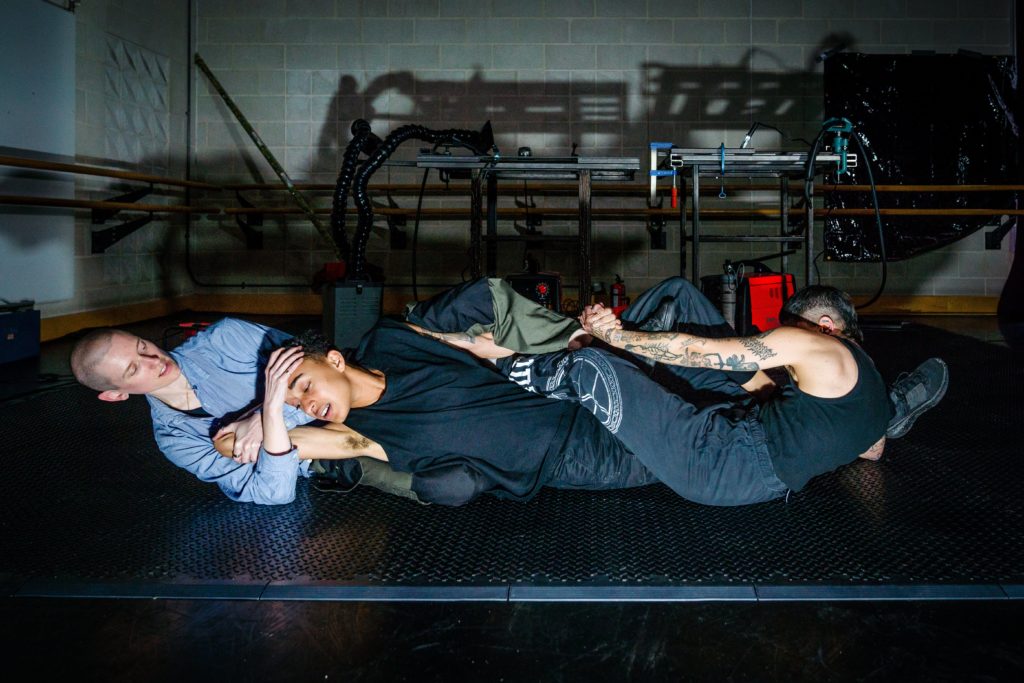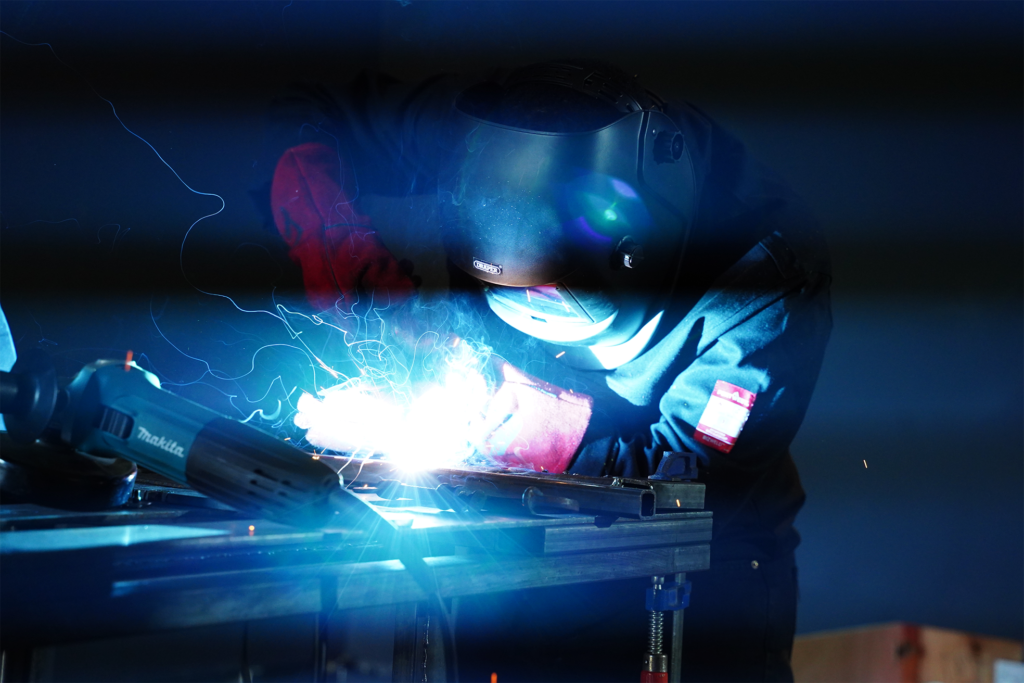Words by Katie Hagan.
I’m speaking to artist Eve Stainton just after they have finished an intense two-week period of cracking open their new work Impact Driver, which comes to the ICA this week. On our call Manchester-born Eve is energised by this electric week of discovery so we get straight into talking about institutional politics and ethical modes of making, the latter of which is not only present in Eve’s previous work Dykegeist, a piece dispelling ideas of the lesbian predator which toured last year, but Impact Driver too.
Without wanting to ‘code’ them, Eve’s work invites and looks at ideas and politics around queerness and its intersections with race and class. They’re known for creating work that is experimental, trippy and risky when it comes to visual aesthetics plus the way Eve approaches the making process.
“I’ve always had a commitment to ethical modes of making,” Eve begins. “At the beginning of the pandemic I felt like I was on the precipice of choreographing myself out of the scene as I was having real trouble getting onboard with institutional politics. I went through a really challenging time. To get myself out of it I asked myself: How can I bring ethical modes of making, and people that share my values, into the research spaces within dance institutions?”
Bringing people into dance spaces is one example of how their approach to Impact Driver, and indeed previous works, is disrupting institutional modes. “I was very intentional in my approach to work with non-movement trained creatives,” they say. Eve’s biggest production to date, Impact Driver brings a host of mighty collaborators together that go beyond what you think would be typical collaborators on a dance project.
Impact Driver’s performers are curator, artist, writer and facilitator Imani Mason Jordan; Romeo Roxman Gatt, a visual artist, curator, performer and filmmaker; and Tink Flaherty, a performance maker creating work from a working-class autistic perspective. With live sound performed by musician Leisha Thomas, making music under alias AlphaMaid, and Mica Levi, a longstanding collaborator of Eve’s who works between orchestral film scores to more low-fi sounds. There’s also a welding manager, access dramaturg and embodied writer, artist care person and live audio describer.
“The silent dancer complex is 100% a thing and I’m actively going against it.”
An approach like this feels quite radical, especially considering part of Impact Driver’s research took place at Sadler’s Wells, the project’s co-commissioner and known as one of the biggest dance institutions in the UK: “Not only is it powerful for a non-binary, masc-presenting lesbian like me to be in that kind of space, but it’s also powerful for the collaborators who aren’t usually or systemically seen in those influential dance institutions,” says Eve. “It’s kind of empowering that all these people are coming together to create something with this in-built rich resistance to institutional modes in a respectful and caring way.”
Eve explains that this atmosphere is refreshing. “I’m fascinated by dance spaces and how exclusive they can be” they say. “I’d like to positively change these spaces because I’ve had experiences in dance companies or auditions that have been totally fucked.”
These experiences have fed into Eve’s behaviour as project director, as they go on to highlight: “Over time I’ve realised it’s really the responsibility of the person who’s holding that space to be transparent, approach with care, and be aware and real with the people you invite into the room. There’s a lot of respect in the Impact Driver group which means the culture of the space feeds into the creative decision making.”
Atmospheres in dance spaces can be highly strung and silencing for dancers, but this wasn’t necessarily the case for Impact Driver’s research stage. “People definitely had the agency to speak; have a conversation; go to the toilet,” Eve says. “The silent dancer complex is 100% a thing and I’m actively going against it.”

Our conversation turns to discussing what Impact Driver is about and how the piece moves. What can audiences expect (or not expect?)
“Impact Driver is definitely situated in my wider research around the politics of dance spaces and questioning systemic structures,” says Eve. “The piece itself however focuses on how to generate atmospheres of suspense without there being a traditional climax. It looks at shifting linear narratives or how to remain in suspense on suspense’s own terms, without conventional codes framing our understanding of what suspense should be or involve.”
“There’s some really on-the-nose ways of creating suspense i.e., a creaky door,” Eve continues. “I guess that feeds into my continuing research around how to work with stereotypes in live practice and how blunt and essentialist stereotyping is.”
Eve goes on to say that, looking at Impact Driver from an identity politics realm, suspense speaks to the undercurrent of societal oppression that people like them – a masc-presenting,non-binary lesbian – experience. “I’m very interested in how suspense is empowering for marginalised individuals in a space.”
Another key part of Impact Driver, and one which is present in Eve’s previous work Dykegeist, is the existence of live negotiation in performance and how this creates multi-layered experiences for the audience and performers.
“I create scenarios of live negotiation in my work” says Eve, “whether that is between the audience, performer or materials. I get really excited about how things get negotiated in the moment that aren’t necessarily simple to resolve. I like the idea of there being resistance, difference or conflict in a space.”
Welding metal is one material that Eve is particularly interested in utilising. “Watching welding either in a performance or non-performance space is quite interesting because you’re negotiating something alchemical in real time. It’s a risky and complex situation.”
With my dad a construction worker, the combination of welding and dance is unexpected but magnetic to me. The riskiness and danger of welding makes for an interesting pairing with dance. *I didn’t bring up Flashdance during my conversation with Eve but as I write this and remember our conversation, maybe I should have.*
Back to our actual conversation, I ask Eve what piqued their interest in welding. “It was actually metal first,” they say. “I started working with metal on a previous project just before the pandemic, Rubby Sucky Forge, where I worked with 2-metre long scaffolding poles. At the time of making Rubby Sucky Forge I was in London’s queer scene, and there was this aesthetic that queerness equaled pastel colours and softness. But what if your physicality doesn’t relate to softness or a particular aesthetic? Metal is hard and brittle, so for me, it represented another kind of queerness.”

In Impact Driver, Eve is borrowing the logic of the welding studio and bringing it together with dance. The performers all had to attend welding workshops so they could weld. Welding manager, Hester Moriarty Thompson, provides consultancy and guidance. Without giving too much away, in Impact Driver there will be two worlds that the audience and performers enter into. There will be a welding microcosm or hub with actual physical walls, for safety reasons, situated in the performance space. The performers will be welding live in front of the audience, negotiating and renegotiating how people and objects take shape and become layered with multiple meanings.
Welding in a dance studio sounds like a health and safety nightmare so I ask what the reception has been like from the dance organisations Eve is working with. “The building management team at Sadler’s Wells were a little hesitant initially but spoon realised how invested we are in the safety of the audience and performers,” they say. “We’ve worked with the institutions to make it happen and it’s been great so far. Yes, it feels quite rebellious to have done this, but it’s important for all audiences to be exposed to experimental works that cross between mediums and challenge expectations.”
Impact Driver show dates: Thurs 28 to Sat 30 Sept, 8pm, ICA London, Thurs 26 Oct Take Me Somewhere festival Glasgow. Header image by Anne Tetzlaff.
Collaborators
Concept and Choreography: Eve Stainton
Performance: Tink Flaherty, Romeo Roxman Gatt, Imani Mason Jordan, Mica Levi, Eve Stainton & Leisha Thomas
Sound World: Leisha Thomas & Mica Levi
Producer: Michael Kitchin
Set Design and Fabrication: H S Design Studios
Production Manager: Helen Mugridge
Lighting Designer: Charlie Hope
Costume Designer: Ella Boucht
Welding Manager: Hester Moriarty Thompson
Dramaturgical Support: Liz Rosenfeld & Jamila Johnson-Small
Access Dramaturg and Embodied Writer: Kat Bailed
Artist Care Person: Seyi Adelekun and Madinah Farhannah Thompson
Artist Support Worker: Andrew Mitchelson
Choreographic Support: Florence Peake
3D Typography: Bora AKA Pauline Canavesio
Live audio description: SoundScribe
